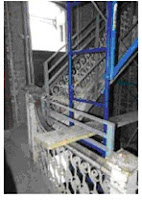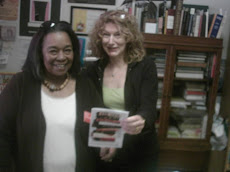As recently as 2003, the Broad Street Bank Building was New Jersey’s number one most endangered building and the New Jersey capitols city's largest blighted building. Today, through the extraordinary efforts of a visionary developer, The National Park Service listed the Broad Street Bank on the National Register of Historic Places on Jan. 17,2008 (reference #07001404)http://www.nps.gov/nr/listings/20080125.HTM. The State of New Jersey listed the Bank on the State Register of Historic Places on Sept. 20, 2007. During the adaptive reuse and rehabilitation process, one of BSBB's stairwells meets U.S. Secretary of the Interior's Standards for Rehabilitation: Maintains historic character while meeting modern code requirements. Our hat's are off for Bayville Holdings LLC and Mr. Richard Libbey for saving a national treasure and providing America with 124 new modern, energy-efficient, and environmentally safe apartment units and much-needed downtown commercial spaces. GREEN, SMART, AND SUSTAINABLE!


Left: Sample installation of railing modification first proposed did not meet the Secretary’s Standards -- Right: Revised railing that better relates to historic design and meets the Standards.
Application 1 Incompatible (Left) treatment revised to meet the Standards): The interior of a circa 1900 bank building featured this very elaborate stair railing. The railing initially proposed to comply with code requirements was too obtrusive and negatively impacted the delicate detailing of the historic railing. Accordingly, a more compatible (right) (and more refined) supplemental railing was designed consisting of only two, much thinner rails supported by posts capped with finials. The revised design meets the Standards.
To obtain a pdf file of of the U.S. Dept. of Interior's rendering on BSBB's stairwell restoration and to see other models, please email GSS Central @ gsscentral@yahoo.com to have a copy sent to you.
For brief history of the Broad Street Bank Building, please visit "What is Smart Growth Project, part 1" You can return here by clicking appropriate link: it's easy..************************************************************************************* In a previous post, "Trenton's Broad Street Bank Project's Smart Growth & Community Catalytic Features: Hurdles, Challenges, and Opportunities", we left off with the following statement:
Trenton's Broad Street Bank Project's Smart Growth & Community Catalytic Features: Hurdles, Challenges, and Opportunities
What is a Smart Growth Project, part 2
This GSS-SET posting was initially planned to be a "one-shot", short, and cursory look at the walkable, sustainale, and historic preservationists aspect of Trenton's newly renovated Broad Street Bank Building. Having had the opportunity to work very closely with the lead developer of the project and access to information not gleaned from media accounts of the Building's redevelopment process, I thought I had most of what I needed - al beit, a small amount of documentation and imperical knowledge - to do just a single posts to address the topic as it pertained to this particular, and spectacular, rehabilitative undertaking.The Broad Street Bank Building has been successful in both implementing smart growth principles through its adaptive reuse of the historic structure into a mix-use, mixed-income, sustainably designed, multifamily, and conveniently located complex while retaining its primary historic features and adding in a number of energy-efficient features. Taking into consideration that this project was wrought with many economic, structural, and socio-political hurdles and challenges, Bayville Holdings LCC has given the City of Trenton, the State of New Jersey, and the American Republic a model example of building in older, struggling, former industrial urban centers that can be both hard-structurally (bricks and mortar) sound, economically viable, and soft-structurally (people) oriented tying together the human, built, and natural environments."
Sensing the need to double check my data, I found that this development has met, set, and implemented more best practices than meets the eye and, most definetly, more than has been covered in Trenton's metropolitan media, both print and digital. Thusly, I decided to extend and expand our look at BSBB's smart growth, sustainable, and historic features into a series of postings for GSS-SET Central, the first of which you are reading now. In fact, to make your reading and research experience easier than mine has been, I have inserted hyper-links to key documention and highlighted them "in bold italic underlined font/style" so you, too, can conduct your own study of these fascinating most instructive principles of green, smart, and sustainable growth policies, practices, and projects. This is the educational and functional essence of GSS-SET Central and, again, we welcome and encourage visitors to this site to share their own views, comments, experiences, and intiatives with others.
Is Historic Preservation Green?
This was the queston asked and the theme of a presentation at the American Institute of Architect's Conference 2007, which featured key-note lecture was delivered by Victoria T. Jacobson, AIA of the National Park Service (Sante fe, NM).
One of the first questions to ask and areas to explore is, "What is 'green' or 'sustainable'?"
In addition to energy and water conservation, sustainable building practices incorporate environmentally sensitive site planning, resource efficient building materials and superior indoor environmental quality. Some of the key benefits are:
1) lower electric and water utility costs;
2) environmentally effective use of building materials;
3) enhanced health and productivity;
4) long-term economic returns;
5) reduced environmental impact;
We will examine most, if not all, of Broad Street Bank's green, smart, and sustainable features in this series which will resume with part 2 Wednesday, February 20 2008. Please feel free to post your comments, questions, suggestions, and report any broken links. Thanks for visiting and enjoy the rest of GSS-SET Central.





































No comments:
Post a Comment